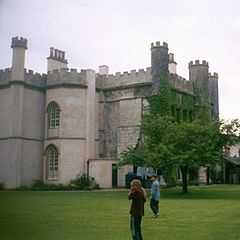Wiverton Hall
| Wiverton Hall | |
|---|---|
 | |
 | |
| General information | |
| Type | English country house |
| Location | Tithby |
| Town or city | Bingham |
| Country | England |
| Coordinates | 52°55′12″N 0°56′26″W / 52.920112°N 0.940691°W |
| Construction started | 1450 |
| Renovated | 1814 |
| Client | Sir Thomas Chaworth |
| Designations | Grade II* listed building |
Wiverton Hall is an English country house near Tithby, Nottinghamshire.[1] The village of the same name became completely depopulated, perhaps as a result of enclosure in 1510.[2] The village of Wiverton (earlier pronounced "Werton"),[3] was impoverished and only five houses remained. All but the Grade II* listed gatehouse of the mansion was destroyed in the English Civil War.
Wiverton Hall is considered to have been established by Sir Thomas Chaworth (d. 1458/9)[4] in 1450. In 1627 his descendant, Sir George Chaworth (d. 1639) was created Viscount Chaworth of Armagh, and his son John Chaworth (d. 1644) the second Viscount, was living at Wiverton.
English Civil War
Lord Chaworth supported Charles I of England and in December 1642 fortified Wiverton Hall to make it a garrison for the King. In June 1643, Queen Henrietta, on her way from Newark, wrote to the King: ‘I shall sleep at Werton [Wiverton], and thence to Ashby, where we will resolve what way to take.’ Among other royal visitors were Prince Rupert of the Rhine and his brother Prince Maurice, who after visiting the King in Newark rode to Wiverton with about 400 troops and stayed there until they could settle their future plans. From Wiverton it was that Prince Rupert addressed a letter to the Parliament, asking for a pass for himself, his brother, and other noblemen and gentlemen to leave England.
They left Wiverton and on 4 November 1645, the garrison commanded by Lord Chaworth surrendered to the troops under Major-General Poyntz. Major-General Sydnam Poyntz had taken Shelford Priory by storm on the previous day went to Wiverton and destroyed it to prevent its use as a garrison.
Current building

The surviving gatehouse was then used as a farmhouse until the early nineteenth century.The current house was erected in 1814 in the Tudor Gothic Revival style.[5] In its restored form the mansion remained the property of the Chaworths until the family became extinct in the direct male line. Mary Chaworth conveyed the property to the family of Musters by her marriage in August 1805 to John Musters of Colwick Hall.
At the beginning of the 20th century the Hall was the home of John Patricius Chaworth-Musters who also owned Annesley Hall, Nottinghamshire. He and his wife had six sons, five of whom fought in the First World War. Of these Patricius George died of wounds in 1915, Philip Mundy was killed in action in 1917 and Robert weakened by poison gas, died of influenza in 1918.
Between 1923 and 1938 the house was let out to tenants, one of whom was Mrs D’Oyley Ransome. In 1938 it was sold by John Neville Chaworth-Musters along with its estate of 2,170 acres to the Crown and was for a period the home of Major-General Sir Miles Graham and Lady Graham. It was during the Grahams' time that a visit was made by Bernard Montgomery, 1st Viscount Montgomery of Alamein on 21 August 1948.
Anglican parishes
The hall gives its name to the Wiverton ward of Rushcliffe Borough Council, as well as the group of Anglican parishes that surround it:
- St Andrew's Church, Langar
- St Giles's Church, Cropwell Bishop
- Holy Trinity Church, Tythby
- St John's Church, Colston Bassett
- St Mary's Church, Barnstone
- St Michael and All Angels' Church, Elton on the Hill
References
- ↑ Nottinghamshire. History, directory and gazetteer of the county... White Francis. 1864
- ↑ NCC Countryside Appraisal. South Nottinghamshire Farmlands. Retrieved 8 November 2014.
- ↑ Heinrich Mutschmann: The Place-Names of Nottinghamshire: Their Origin and Development (Cambridge, UK: Cambridge UP, 1913), p. 154. Retrieved 3 February 2015.
- ↑ The liturgy in medieval England: a history. Richard William Pfaff. 2009
- ↑ Nikolaus Pevsner, The Buildings of England: Nottinghamshire. London. 1979
| Wikimedia Commons has media related to Wiverton Hall. |